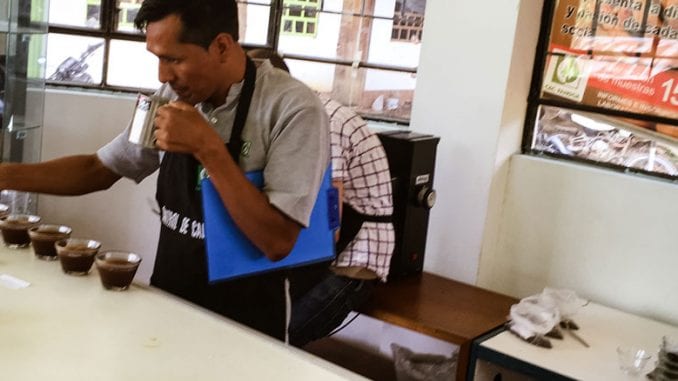
We continue to follow Jackson in Peru as he explores how coffee is graded in Peru and how grading standards affect the growers of the Pangoa cooperative.
There are coffee regions we know well, but there are regions where violence, accessibility, and poverty have detrimentally affected coffee production. In this ongoing series, we’ll highlight different coffee-producing countries and discuss the struggles producers face and how activists, baristas, and various non-profit organizations are helping to make coffee from these countries viable, more profitable, and available to a wider market.
BY JACKSON O’BRIEN
SPECIAL TO BARISTA MAGAZINE
All photos courtesy of Peace Coffee.
After a breakfast of eggs, papaya and mediocre but powerful coffee at the hotel, Felipe, my colleague from Cooperative Coffees, and I went to the Pangoa cupping lab. It was not much different than the facility we have in Minneapolis, complete with tables, brewing equipment, grinders and, of course, cups and spoons. We cupped small lots until noon. Our lunch was a fabulous ceviche de doncella (a local river fish). We then cupped small lots until about 5 PM. It was a long day, but I learned a lot and tasted some very good coffee.

The big discovery for me was that Pangoa co-op grades their own coffees much harsher than Cooperative Coffees or Peace Coffee does. The cuppers at the Pangoa lab consistently scored coffee two points lower than Felipe or I did. Wilmer, the Pangoa head grader, had us taste many smaller lots to better understand the cup profiles the cooperative produces. Given the impact grades have on coffee bean prices, it became clear to me how important it is for buyers and sellers to calibrate their quality expectations and make sure to speak the same language regarding quality.

I also found out that the co-op had been running an internal quality competition and twelve farmers had won. Each of these farmers received a quality bonus on top of their normal payment and had their names published on the door of the co-op for bragging rights. The competition did not promise that the co-op would be able to sell the coffee at a premium; rather, it was a ‘rising tide lifts all boats’ program. Pangoa hoped that financial and social incentives to produce higher quality coffees would inspire more farmers to produce better coffee in the future.

The only downside to the contest was that farmers had grown great coffees, but very little of each lot. Each of the participating producers brought in around five-six quintals—just two to three bags of green coffee. This amount would be difficult to export, import and sell separately. The idea was floated of combining the contest winners into one single ‘contest winner’ lot of around 20 bags.
In addition to these small lots, I sampled a microlot consisting of late-harvest coffees that had come from producers at the highest elevation farms. It tasted super great, but it had been promised to another buyer already!
 ABOUT THE AUTHOR
ABOUT THE AUTHOR
Jackson O’Brien has worked in the coffee business his whole adult life. He is the Head Barista at Peace Coffee in Minneapolis. When he’s not making drinks, Jackson can be found drinking beer, cooking, finding new and interesting foods to eat, listening to socially irresponsible metal and/or rap music, finding the newest cat videos on the internet, going on adventures with his wife, playing music with friends or family, or playing croquet.

